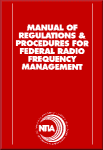Publications
Use the filters below to narrow publications by offices, programs or categories
Request for Comments on Proposals and Positions for the 2020 World Telecommunication Standardization Assembly
NTIA is seeking comments and recommendations on priorities that advance international communications and information policies at the International Telecommunication Union (ITU). Additionally, NTIA seeks input from stakeholders and interested parties on its proposals and positions on matters that will be addressed at the 2020 World Telecommunication Standardization Assembly (WTSA– 2020) of the ITU.
Interference Prevention, Detection, and Resolution (IPDR) Briefing 04/22/2020
Non-Federal Current and Future Spectrum Requirements Briefing 04/22/2020
GUIDE to NATIONAL TELECOMMUNICATIONS AND INFORMATION ADMINISTRATION
Regulation and Management of Federal Government Radio Frequency Spectrum
The National Telecommunications and Information Administration (NTIA) is the federal agency legally authorized to regulate and manage the Federal Government agency use of the radio frequency spectrum. This landing page provides guidance on using the NTIA spectrum management documents. The documents are presented in an e-Book format consisting of:
- Manual of Regulations for Federal Radiofrequency Spectrum Management, (the Manual) that presents the NTIA legal authority, policies, and regulations; and
- A series of handbooks that present procedures on NTIA spectrum management actions
NTIA Letter to FCC Chairman Re Ligado Applications
NTIA today filed materials with the FCC to supplement its letter to the Commission of December 6, 2019, wherein it indicated that NTIA, on behalf of the executive branch, was unable to recommend approval of applications from Ligado Networks to modify licenses in L-Band spectrum in order to provide certain terrestrial wireless services.
January 2021 Edition - January 2023 Revision
Entire Manual
Manual by Chapter
1.1 AUTHORITY AND FUNCTIONS DIRECTED BY THE SECRETARY - 1-1
1.2 NTIA AND ITS FREQUENCY MANAGEMENT SUPPORT ORGANIZATION - 1-4
Organization Charts - 1-4
1.3 INTERDEPARTMENT RADIO ADVISORY COMMITTEE - 1-5
Status - 1-5
Bylaws - 1-5
1.4 REIMBURSEMENT REGARDING AUTHORIZATION FOR SPECTRUM USE - 1-14
- 1.1 AUTHORITY AND FUNCTIONS DIRECTED BY THE SECRETARY - 1-1
- 1.2 NTIA AND ITS FREQUENCY MANAGEMENT SUPPORT ORGANIZATION - 1-4
- Organization Charts - 1-4
- 1.3 INTERDEPARTMENT RADIO ADVISORY COMMITTEE - 1-5
- Status - 1-5
- Bylaws - 1-5
- 1.4 REIMBURSEMENT REGARDING AUTHORIZATION FOR SPECTRUM USE - 1-14
Organization Charts: 1-4
Status: 1-5
Bylaws: 1-5
Notice of 04/22/2020 CSMAC Open Meeting
This notice announces a public meeting of the Commerce Spectrum Management Advisory Committee. The Committee provides advice to the Assistant Secretary of Commerce for Communications and Information and the National Telecommunications and Information Administration (NTIA) on spectrum management policy matters.
NTIA Appendix to the National Plan on Unlicensed and Licensed by Rule Operations in Furtherance of the Ray Baum's Act
This Appendix was prepared by the National Telecommunications and Information Administration (NTIA), in consultation with the Office of Management and Budget (OMB), and was sent to Congress and shared with the Federal Communication Commission in response to Section 618(d) of the MOBILE NOW Act.

